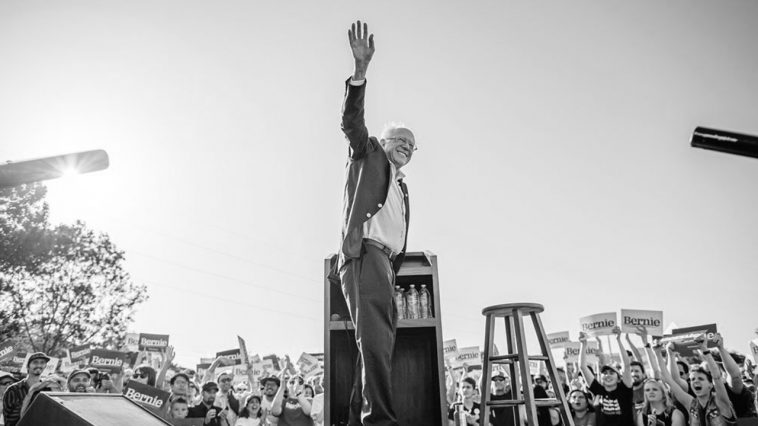Michael Kniat takes a look at how Bernie Sanders is building a grassroots movement, and the people who are tasked with making it happen.
On Friday night, October 23, I joined the first nationwide conference call, as one of several thousand volunteer campaign organizers, sponsored and conducted by Bernie Sanders 2016. For the benefit of those who were not in on the dialogue, I’d like to share a few choice takeaways from Zack Exley’s presentation, along with some observations of my own:
- This type of massive, grassroots, volunteer-driven campaign has never been successfully accomplished before. It’s never even been attempted before, at least not on this scale. It is unique – not only in American history, but it is unique period.
- Win or lose, the Bernie Sanders presidential campaign of 2016 will still be talked about by political scholars and historians many years from now. You’ll be able to tell your children and grandchildren that you were part of it.
- The campaign has already made significantly greater progress than even Barack Obama’s groundbreaking presidential campaign of 2008. In terms of size and scope of Bernie’s mass rallies, in terms of social media reach, in terms of the sheer numbers of individual donors attracted at an earlier stage of the process than ever before, in terms of high fundraising thresholds reached earlier than ever, in terms of the ballooning number of volunteers, and much more, this campaign is literally rewriting the record books.
That said, and notwithstanding the extremely impressive and encouraging results of the past six months, we are not yet collectively at a point in the campaign’s progress that, if projected linearly into February, March & April, would allow Bernie to win the Democratic nomination. In fact, we’re not yet even close. We still have time to get ahead of the curve. But we – and that means the entire community of Berniephiles across the country – need to pick up the pace. Building the infrastructure of a political revolution takes time, and robust early progress offers the benefits of an organizational multiplier effect that will pay off big-time, throughout the entire lifespan of the campaign. Think of it as a form of compound interest – and the huge difference in return between an investment that begins late…and an investment that begins early.
The juxtaposition of these two conditions – the astonishing, explosive growth of the Bernie Sanders 2016 presidential campaign, plus the fact that even faster, even more explosive growth is required in order to win – ought to impart a sense of real urgency to each one of us. And it ought give each one of us a very sober appreciation of the true magnitude of the challenge we’re up against. If Bernie wins in Iowa and New Hampshire next February, as we suspect he will, the campaign ground game has got to already be fully established, ready to shift into overdrive immediately, in order to take full advantage of the new momentum. You and I are building the transmission for that machine right now.
I personally believe that the fate of this campaign will be largely determined by what happens during the next six to eight months. As challenging as it will be to beat the Republican nominee next November – and the Republicans are always a dangerous and unpredictable threat – the far greater challenge will be to prevail against Hillary Clinton for the Democratic nomination. And a big part of the reason for that is simply that it takes time and resources to build a first-rate campaign infrastructure; the kind of operation that is capable of winning the nomination, and because we won’t have nearly as much time and material resources available by the date of the Iowa Caucuses on February 1 as we will by the date of the general election on November 8.
According to what I understand from the official campaign, the volunteer operation is considered to still be in Phase One (although that will change soon). The priorities are: 1) spread the word about Bernie Sanders far and wide, and 2) grow the organization. And growing the organization means more volunteers – lot and lots more volunteers.
Every time we participate in a public event on behalf of Bernie – whether it be taking a flyering shift, staffing a phone bank for a few hours, or representing Bernie at a local forum, discussion, debate or parade – we help to raise Bernie’s public profile a bit more, and we increase the buzz factor. That kind of excitement is contagious. It draws people to us, seeking a way to become part of the revolution. Be ready.
Whenever you attend a public event for Bernie, be sure to print multiple hard copies of the Bernie 2016 volunteer sign-up form, and bring them with you, along with a clipboard and some pens. Ask the new volunteer to fill out a form, retain it for yourself, then submit that data to the campaign online via its volunteer submission web page, at your earliest opportunity. Be sure to help the new volunteer to get connected into your local Bernie group(s) as well.
At the end of the day, after all the fur has flown and after all the dust has finally settled, I believe that Bernie will emerge as the 2016 Democratic nominee for president. And if that should happen, I believe that Bernie Sanders will go on to become the 45th President of the United States. But nothing is guaranteed. And the journey from here to there is likely to become a knock-down, drag-out slugfest of epic proportions, that will be far more arduous and grueling than we can imagine from the here and now. What happens between now and then could very well be determined by the strength of the foundation that you and I are building together – right now.
Michael V. Kniat is a writer who feels the Bern in New York City.


